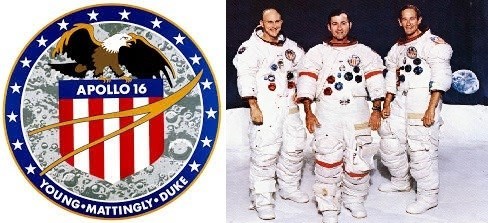NOTE: The listed coordinates are NOT the location of this cache.
Apollo 16 Bonus
This is the 5th of 6 US Spaceflight Apollo Bonus caches. There will be one published on the 51st anniversary for each Project Apollo moon landing. To be certain of deriving the coordinates for this one, you must first find and collect codes from a minimum of 12 of the 27 traditional caches representing all United States Spaceflight Missions of Projects Mercury, Gemini, and Apollo.
Click here to see all 27 traditional US Spaceflight caches.
The Apollo 16 spaceflight was the tenth crewed mission in the United States Apollo space program, the fifth and second-to-last to land on the Moon, and the second to land in the lunar highlands. The second of the so-called "J missions," it was crewed by Commander John Young, Lunar Module Pilot Charles Duke and Command Module Pilot Ken Mattingly. Launched from the Kennedy Space Center in Florida at 12:54 PM EST on April 16, 1972, the mission lasted 11 days, 1 hour, and 51 minutes, and concluded at 2:45 PM EST on April 27.
Young and Duke spent 71 hours—just under three days—on the lunar surface, during which they conducted three extra-vehicular activities or moonwalks, totaling 20 hours and 14 minutes. The pair drove the Lunar Roving Vehicle (LRV), the second produced and used on the Moon, for 26.7 kilometers (16.6 mi). On the surface, Young and Duke collected 95.8 kilograms (211 lb) of lunar samples for return to Earth, while Command Module Pilot Ken Mattingly orbited in the command and service module (CSM) above to perform observations. Mattingly, staying with the command module, spent 126 hours and 64 revolutions in lunar orbit. After Young and Duke rejoined Mattingly in lunar orbit, the crew released a subsatellite from the service module (SM). During the return trip to Earth, Mattingly performed a one-hour spacewalk to retrieve several film cassettes from the exterior of the service module.
Apollo 16's landing spot in the highlands was chosen to allow the astronauts to gather geologically older lunar material than the samples obtained in three of the first four Moon landings, which were in or near lunar maria (Apollo 14 landed in the Fra Mauro Highlands). Samples from the Descartes Formation and the Cayley Formation disproved a hypothesis that the formations were volcanic in origin.
Apollo 16 Patch and Mattingly, Young, & Duke

FLIGHT SUMMARY:
| Commander:_ |
_John W. Young |
| Command Module Pilot:_ |
_Thomas K. Mattingly II |
| Lunar Module Pilot:_ |
_Charles M. Duke Jr. |
| Launch Vehicle:_ |
_Saturn V |
| Height:_ |
_363.0 feet |
| Stages:_ |
_3 |
| Stage 1 Diameter:_ |
_33.0 feet |
| Stage 1 Thrust:_ |
_7,891,000 lbf |
| Stage 2 Diameter:_ |
_33.0 feet |
| Stage 2 Thrust:_ |
_1,155,800 lbf |
| Stage 3 Diameter:_ |
_21.7 feet |
| Stage 3 Thrust:_ |
_232,250 lbf |
| Launch Date & Time:_ |
_April 16, 1972, 17:54:00 UTC |
| Landing Date & Time:_ |
_April 27, 1972, 19:45:05 UTC |
| Duration:_ |
_11 days, 1 hour, 51 minutes, 5 seconds |
Travel (that’s why it’s a D4.0):
Prerequisite:
To find this cache, you must have collected and recorded the numbers associated with the coordinate code letters of at least 12 of the 27 traditional caches representing all United States Spaceflight Missions of Projects Mercury, Gemini, and Apollo. Click here to see all 27 traditional US Spaceflight caches.
Once you have all the codes, you will find the cache at N AB CD.EFG W HJK LP.QRS. To derive the final coordinates for your search, do the following math (the small letters correspond to the value you recorded when you found the caches):
- A = a - 1
- B = g + 5
- C = e - 4
- D = k - 3
- E = f - 1
- F = m + 3
- G = h - 3
- H = a - 3
- J = b - 1
- K = a - 3
- L = d - 5
- P = j + 8
- Q = c + 3
- R = e + 1
- S = p - 4
The US Spaceflight traditional caches are located in the following counties:
- 19 in Contra Costa
- 2 in Alameda
- 1 in Marin
- 1 in Sacramento
- 3 in Solano
- 1 in Sonoma
Code Frequency:
- a: 4 caches with this code
- b: 2 caches with this code
- c: 2 cache with this code
- d: 2 cache with this code
- e: 2 caches with this code
- f: 2 caches with this code
- g: 3 caches with this code
- h: 2 caches with this code
- j: 2 cache with this code
- k: 2 cache with this code
- m: 2 caches with this code
- p: 2 caches with this code
`

You can validate your puzzle solution with certitude.
`
If you can't get the coordinates to come out right, recheck your work and try again. If you are still having problems, send me a message with the coordinates you derived and the data values you used for the coordinate code letters.
TO LEARN MORE:
Click here to see the Wikipedia description for Apollo 16.
Click here to see the Wikipedia description for Project Apollo.
Click here to see the Wikipedia description for the Space Race.